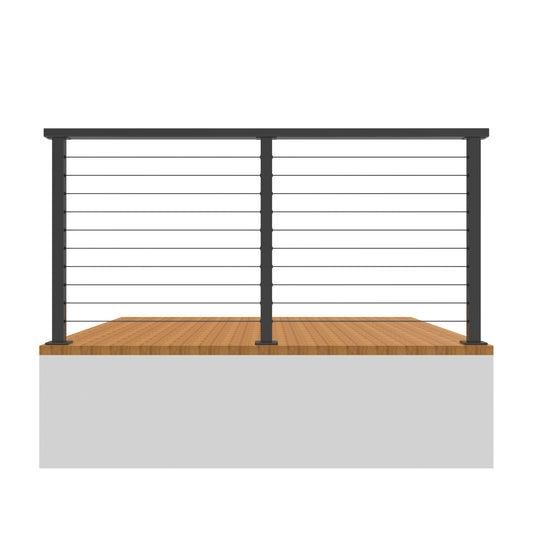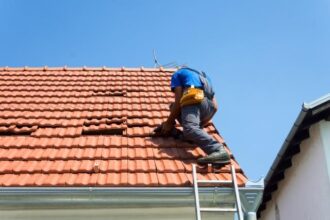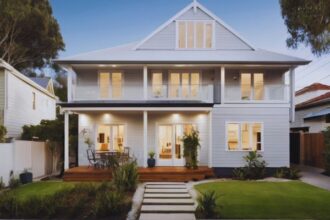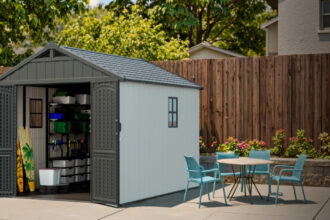Cable railing systems have transformed outdoor and indoor spaces with their sleek, minimalist appearance and exceptional functionality. At the heart of these systems are cable railing posts, which serve as the foundational elements that support horizontal cables while maintaining an unobstructed view. These posts combine engineering precision with aesthetic appeal, making them increasingly popular among homeowners, architects, and designers who seek both durability and contemporary style.
Modern cable railing posts offer versatility that extends beyond traditional railing options. Whether you’re designing a deck overlooking a scenic landscape, updating a staircase, or creating a balcony with panoramic views, these posts provide the structural support needed while enhancing visual openness. Available in various materials including stainless steel, aluminum, and wood, they adapt to diverse architectural styles from coastal modern to industrial chic. This article explores the essential aspects of cable railing posts, from understanding their fundamental characteristics to selecting and installing the right system for your space, helping you make informed decisions that balance safety, durability, and design excellence.
Understanding Cable Railing Posts
Cable railing posts are vertical structural components designed to anchor and support horizontal stainless steel cables in railing systems. Unlike traditional balusters or pickets, these posts create an open framework that allows cables to span between them, maintaining tension while providing the necessary safety barrier. The posts bear the load of the cable tension and any applied forces, making their strength and proper installation critical to the system’s overall performance.
The primary benefit of cable railing posts lies in their ability to preserve sightlines while meeting building codes and safety requirements. Traditional railings with closely spaced vertical elements can obstruct views, but cable systems minimize visual interference, making them ideal for locations where scenery matters. Beyond aesthetics, these posts offer practical advantages including low maintenance requirements, resistance to weathering and corrosion when constructed from quality materials, and longevity that often exceeds conventional railing options. Their contemporary appearance complements modern architectural trends, adding property value while providing functional safety. The engineering behind cable railing posts ensures they can withstand significant lateral pressure and environmental stresses, from wind loads on elevated decks to the daily wear of high-traffic areas, all while maintaining their refined appearance and structural integrity over decades of use.
Key Characteristics
Modern cable railing posts exhibit several defining characteristics that distinguish them from traditional railing components. Their robust construction typically features solid or thick-walled hollow profiles that resist deflection under cable tension, which can reach several hundred pounds per cable. The posts incorporate precisely engineered holes or channels for cable routing, positioned at exact intervals to comply with building codes that typically require spacing preventing a four-inch sphere from passing through.

Surface finishes range from mirror-polished stainless steel to powder-coated colors, brushed aluminum, or natural wood treatments, each offering distinct aesthetic qualities and maintenance profiles. Quality posts include integrated tensioning mechanisms or compatible hardware systems that allow for precise cable adjustment during installation and periodic maintenance. Their dimensional stability ensures they won’t warp, twist, or deteriorate under environmental exposure, maintaining both function and appearance. The mounting systems vary from surface-mounted base plates to core-mounted installations that penetrate deck surfaces for enhanced strength. These characteristics combine to create posts that deliver reliable performance while contributing to the clean, uncluttered aesthetic that defines contemporary cable railing systems.
Types of Cable Railing Posts
Cable railing posts come in several distinct types, each offering unique advantages based on material composition and installation methodology. Stainless steel posts represent the most popular choice, prized for their exceptional corrosion resistance and strength, particularly in marine or humid environments where salt air and moisture would compromise other materials. Aluminum posts provide a lightweight alternative with excellent weather resistance and come in various powder-coated finishes that expand color options while maintaining durability. Wood posts appeal to those seeking warmth and traditional aesthetics, often combined with metal cable hardware for a transitional design that bridges classic and contemporary styles.
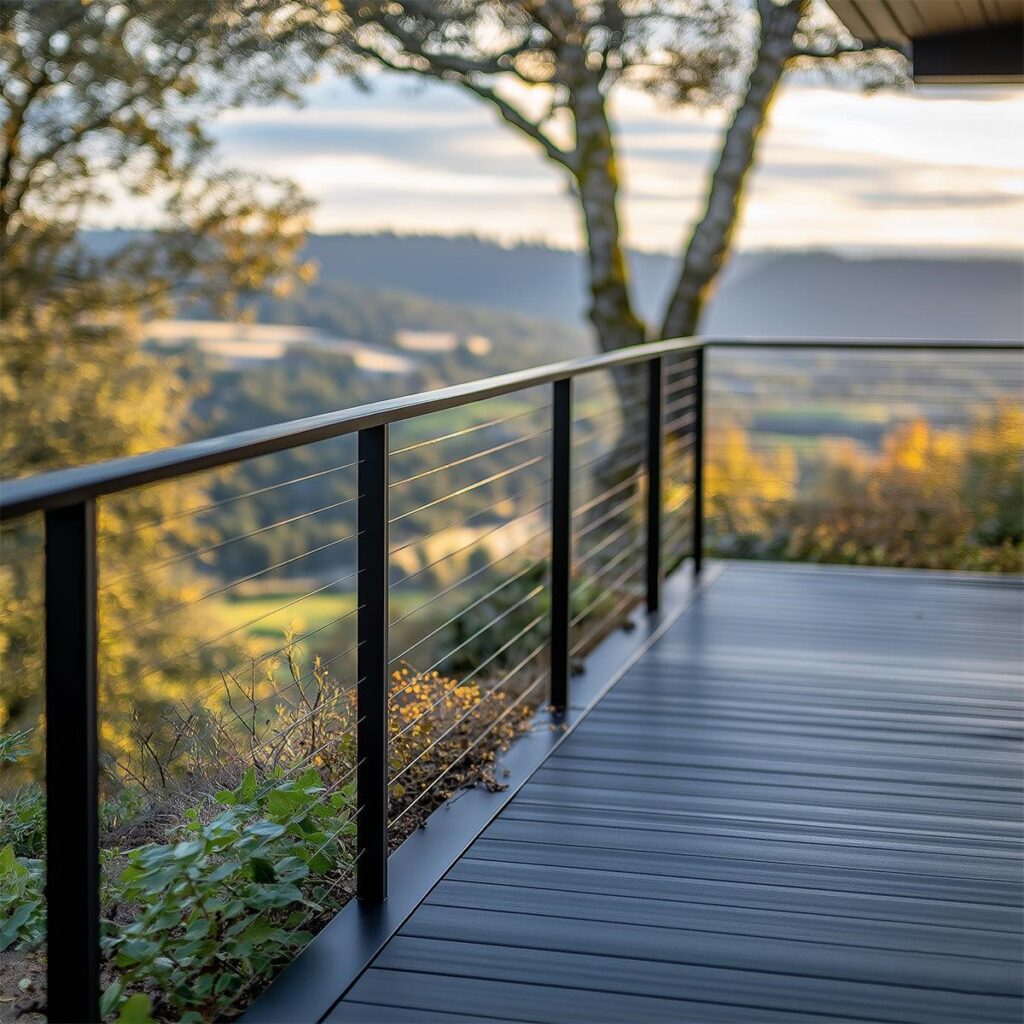
Installation methods further differentiate post types into surface-mounted and fascia-mounted configurations. Surface-mounted posts attach directly to deck surfaces using flanged base plates, offering straightforward installation and easier future adjustments. Fascia-mounted posts secure to the outer rim or face of deck structures, preserving deck surface area and creating a cleaner top appearance. Core-mounted posts penetrate through decking material into structural framing below, delivering superior strength for applications requiring maximum load capacity. Each type addresses specific architectural requirements, environmental conditions, and aesthetic preferences, allowing designers and homeowners to select the optimal solution that balances structural performance with visual impact while accommodating budget considerations and installation complexity.
Engineered Tension Systems
Engineered tension systems represent sophisticated hardware solutions that ensure cable railing posts maintain proper cable tautness throughout their service life. These systems typically incorporate specialized fittings at post termination points, featuring threaded assemblies that allow precise adjustment of cable tension to manufacturer specifications, usually between 200 and 300 pounds per cable. The engineering behind these systems accounts for cable stretch over time, thermal expansion and contraction, and structural movement, providing mechanisms for periodic re-tensioning without requiring specialized tools or professional intervention.
Quality tension systems integrate seamlessly with post design, often concealing adjustment points within post profiles or behind decorative caps that maintain clean aesthetics. Some advanced systems employ spring-loaded tensioners that automatically compensate for minor cable relaxation, reducing maintenance requirements. The hardware components undergo rigorous testing to ensure they won’t fail under sustained load or environmental stress. Proper tension distribution across all cables prevents sagging that could compromise safety or visual appeal, while avoiding over-tensioning that might damage posts or fittings. These engineered solutions transform cable railing posts from simple structural elements into complete systems that deliver reliable, long-term performance with minimal ongoing attention.
Customizable Designs
Modern cable railing posts offer extensive customization possibilities that allow them to complement virtually any architectural vision. Material combinations create distinctive appearances, such as wood sleeves over structural steel cores that provide rustic charm with hidden strength, or brushed stainless posts with powder-coated accents matching exterior color schemes. Height variations accommodate different applications, from standard 36-inch residential deck railings to 42-inch commercial installations or custom dimensions for unique architectural features. Post spacing can be optimized based on cable type and local code requirements, typically ranging from four to seven feet between posts.
Profile shapes extend beyond standard square and round options to include rectangular, elliptical, and custom-milled designs that align with specific aesthetic goals. Cap styles add finishing touches, from simple flat plates to decorative ball tops, pyramid caps, or illuminated LED options that enhance nighttime ambiance and safety. Surface treatments provide further personalization, including brushed, polished, sandblasted, or patinated finishes that age gracefully or maintain pristine appearances depending on preference. This design flexibility ensures cable railing posts integrate seamlessly with existing architectural elements while expressing individual style, whether the goal is minimalist modernism, industrial edge, coastal elegance, or transitional sophistication that bridges multiple design languages.
Installation Guide
Installing cable railing posts requires careful planning and precise execution to ensure structural integrity and code compliance. Begin by determining post locations based on cable span requirements and local building codes, typically spacing posts between four and seven feet apart depending on cable diameter and tension specifications. Mark exact positions on the deck surface or fascia, ensuring alignment and equal spacing using a chalk line and measuring tape. Verify that mounting locations align with underlying structural framing capable of supporting the loads generated by cable tension and lateral forces.
Prepare mounting surfaces by drilling pilot holes for surface-mounted posts or cutting through decking material for core-mounted installations, ensuring holes are plumb using a level. Secure posts using manufacturer-specified fasteners, typically stainless steel lag bolts or through-bolts that penetrate into solid framing members. Apply appropriate sealants around penetrations to prevent water intrusion that could compromise structural integrity. Once posts are firmly anchored, drill cable holes at precise intervals using a drill guide to maintain consistent spacing and alignment across all posts, typically positioning holes at three to four-inch intervals vertically.
Thread cables through posts starting from one end, securing initial terminations before proceeding to tensioning. Use tensioning tools or hand-tightening mechanisms to achieve manufacturer-recommended tension levels, working systematically from bottom to top and checking tension with a gauge to ensure uniformity. Install end caps and trim pieces to conceal hardware and provide finished appearances. Conduct final inspections verifying all connections are secure, cables meet spacing requirements, and the system can withstand applied pressure without excessive deflection. Allow twenty-four hours before subjecting the railing to full use, then recheck cable tension after one week as initial stretching occurs, making adjustments as needed to maintain optimal performance and safety standards.
Choosing the Right Posts
Selecting appropriate cable railing posts requires evaluating several critical factors that influence both performance and aesthetics. Consider environmental conditions first, choosing stainless steel for coastal or high-humidity locations where corrosion resistance is paramount, aluminum for general outdoor applications requiring lightweight durability, or treated wood for sheltered areas where traditional warmth is desired. Assess structural requirements by calculating expected loads based on railing height, cable spacing, and local wind exposure, ensuring selected posts meet or exceed these demands with adequate safety margins.
Match post style to architectural context, selecting profiles and finishes that complement existing design elements rather than conflict with them. Contemporary homes benefit from sleek stainless or powder-coated aluminum posts, while transitional designs might incorporate wood posts with metal hardware. Evaluate installation complexity relative to skill level and available tools, recognizing that surface-mounted systems offer simpler installation than core-mounted alternatives requiring precise alignment and structural modifications. Budget considerations should balance initial costs against long-term maintenance requirements and expected lifespan, understanding that premium materials typically deliver superior durability and reduced upkeep expenses over decades of service. Manufacturers like Senmit offer various post configurations designed to meet different project requirements, from residential deck applications to commercial installations.
Professional Installation
Professional installation of cable railing posts provides significant advantages that often justify the additional investment beyond diy railing approaches. Experienced installers possess specialized knowledge of local building codes and permit requirements, ensuring compliance that protects homeowners from liability and potential costly corrections. They bring precision tools and techniques that achieve proper post alignment, secure anchoring into structural members, and accurate cable tensioning that meets safety standards while optimizing system performance. Professional crews complete installations efficiently, typically finishing projects in days rather than the weeks that inexperienced installers might require.
Warranty protection represents another compelling reason to choose professional installation, as many manufacturers require certified installer involvement to validate product guarantees covering materials and workmanship. Professionals also carry liability insurance protecting property owners from damages that might occur during installation. Their expertise proves particularly valuable in complex applications involving stairs, angled sections, or challenging architectural features where precise measurements and custom solutions are essential. While DIY installation may seem economical initially, the risk of errors requiring expensive corrections, compromised safety, or voided warranties often makes professional installation the more prudent long-term investment for cable railing systems.
Achieving Long-Term Performance and Style
Modern cable railing posts represent a sophisticated fusion of engineering excellence and contemporary design that transforms spaces while delivering exceptional functionality. Throughout this exploration, we’ve examined how these structural elements provide the foundation for cable railing systems that preserve views, resist environmental challenges, and complement diverse architectural styles. From understanding their fundamental characteristics and tension engineering to navigating material options and installation considerations, cable railing posts offer solutions that meet both practical safety requirements and aesthetic aspirations.
Whether you choose stainless steel for coastal durability, aluminum for lightweight versatility, or wood for traditional warmth, quality cable railing posts deliver decades of reliable performance with minimal maintenance. The investment in proper materials, thoughtful design selection, and skilled installation pays dividends through enhanced property value, preserved sightlines, and enduring visual appeal. As you plan your railing project, remember that these posts are not merely functional components but design elements that define spaces and create lasting impressions. By prioritizing quality materials, code compliance, and professional expertise where needed, you’ll achieve a cable railing system that combines safety, durability, and timeless style for years to come.


